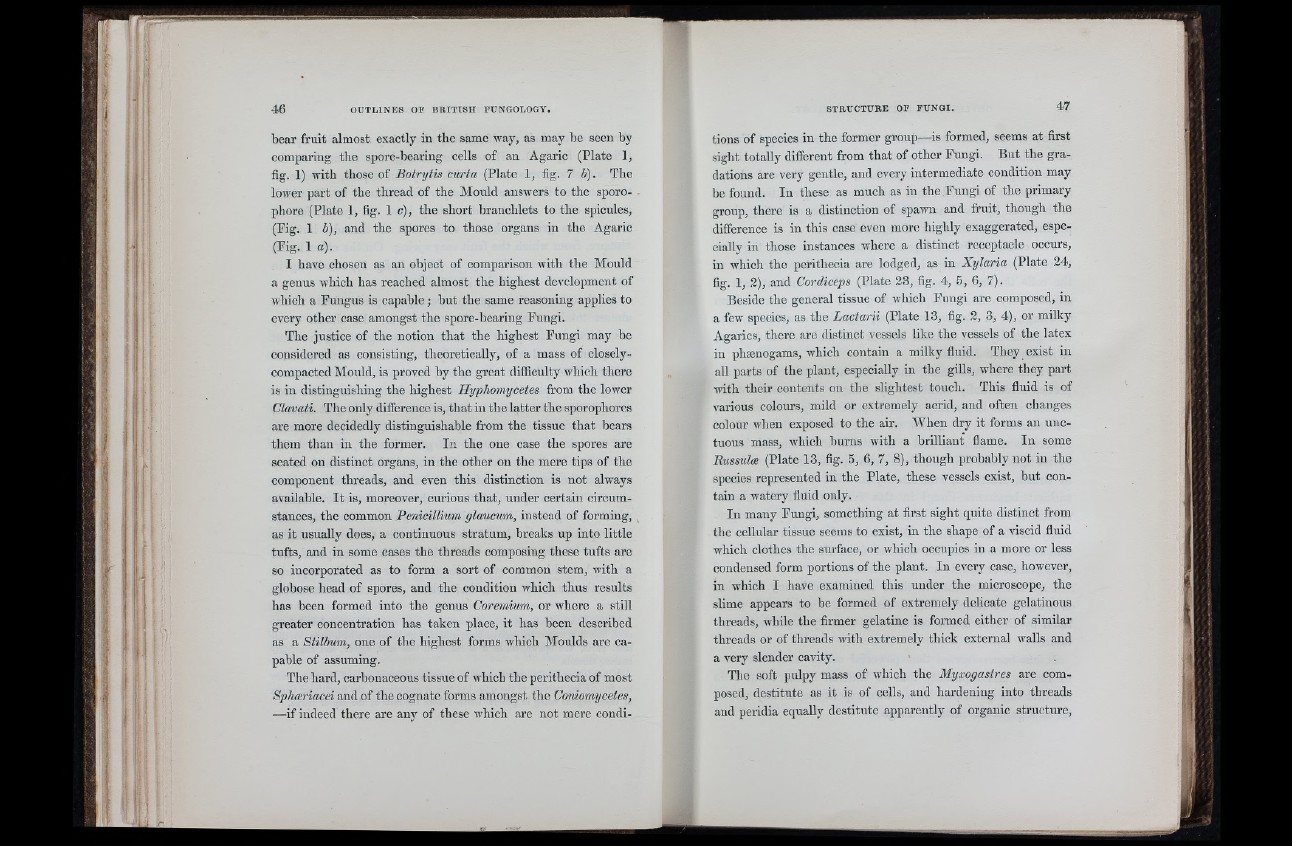
bear fruit almost exactly in the same way, as may be seen by
comparing the spore-bearing cells of an Agaric (Plate 1,
fig. 1) with those of Botrrjtis curta (Plate 1, fig. 7 h). The
lower part of the thread of the Mould answers to the sporo- -
phore (Plate 1, fig. 1 c), the short branchlets to the spicules,
(Pig. 1 b), and the spores to those organs in the Agaric
(Fig. 1 a).
I have chosen as an object of comparison with the Mould
a genus which has reached almost the highest development of
which a Fungus is capable ; but the same reasoning applies to
every other case amongst the spore-bearing Fungi.
The justice of the notion that the highest Fungi may he
considered as consisting, theoretically, of a mass of closely-
compacted Mould, is proved by the great difficulty which there
is in distinguishing the highest Hyphomycetes from tho lower
Clavati. The only difference is, that in the latter the sporophores
are more decidedly distinguishable from the tissue that bears
them than in the former. I s the one case the spores are
seated on distinct organs, in the other on the mere tips of the
component threads, and even this distinction is not always
available. I t is, moreover, curious that, under certain circumstances,
the common Pénicillium glaucum, instead of forming,
as it usually does, a continuous stratum, breaks up into little
tufts, and in some cases the threads composing these tufts are
so incorporated as to form a sort of common stem, with a
globose head of spores, and the condition which thus results
has been formed into the genus Coremium, or where a still
greater concentration has taken place, it has been described
as a Stilbum, one of the highest forms which Moulds are capable
of assuming.
The hard, carbonaceous tissue of which the perithecia of most
Sphæriacei and of the cognate forms amongst the Coniomycetes,
—if indeed there are any of these which are not mere conditions
of species in the former group—is formed, seems at first
sight totally different from that of other Fungi. But the gradations
are very gentle, and every intermediate condition may
he found. In these as much as in the Fungi of the primary
group, there is a distinction of spawn and fruit, though the
difference is in this case even more highly exaggerated, especially
in those instances where a distinct receptacle occurs,
in which the perithecia are lodged, as in Xylaria (Plate 24,
fig. I, 2), and Cordiceps (Plate 23, fig. 4, 5, 6, 7).
Beside the general tissue of which Fungi are composed, in
a few species, as the Lactarii (Plate 13, fig. 2, 3, 4), or milky
Agarics, there are distinct vessels like the vessels of the latex
in phænogams, which contain a milky fluid. They exist in
all parts of the plant, especially in the gills, where they part
with their contents on the slightest touch. This fluid is of
various colours, mild or extremely acrid, and often changes
colour w'hen exposed to the air. When dry it forms an unctuous
mass, which burns with a brilliant flame. In some
Russulæ (Plate 13, fig. 5, 6, 7, 8), though probably not in the
species represented in the Plate, these vessels exist, but contain
a watery fluid only.
In many Fungi, something at first sight quite distinct from
the cellular tissue seems to exist, in the shape of a viscid fluid
which clothes the surface, or which occupies in a more or less
condensed form portions of the plant. In every case, however,
in which I have examined this under the microscope, the
slime appears to he formed of extremely delicate gelatinous
threads, while the firmer gelatine is formed either of similar
threads or of threads with extremely thick external walls and
a very slender cavity.
The soft pulpy mass of which the Myxogastres are composed,
destitute as it is of cells, and hardening into threads
and peridia equally destitute apparently of organic structure.